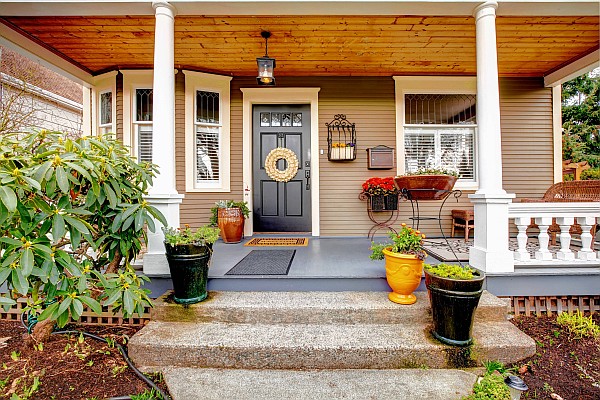Selecting a new front door entails more than just picking out the color.
1. Find the perfect fit
Like a recruiter, you're looking to fill a specific opening so eliminate candidates that aren't the right fit.
"The first question I ask customers is, 'What size is the current entry?' We replace like with like," says Donna Cahoon, co-owner of Today's Entry Doors in Orange, California. That's because to do otherwise would mean redoing the door framing -- a far too costly and complicated job unless you happen to be remodeling. Sticking with the same measurements does not limit your options to the same type of door. For example, "you can, in many cases, go from a double door to a door with two sidelites (glass panels on each side) without any problems or major modifications to the opening, or to an oversize single door with one sidelite," says Ryan Hampton, vice president of the Front Door Co., San Antonio, Texas. homeowners must decide whether they want glass inserts in their door, and how much.
2. Consider the architecture
The new door needs to fit more than just the opening.
3. Balance the glass
Decide how much glass you want for aesthetic and practical purposes. "This is the second question I ask people, after the size of the existing entry," says Cahoon, adding that the type and amount of glass greatly affects price. You can have as little as a peephole on up to a "full lite" door that has top-to-bottom glass to let in natural light. In between are Craftsman-style doors with lites (glass inserts) just at the top, half-lite doors and doors with transoms. "People are moving to doors that don't have as much glass," Hathaway says. The popularity of painted doors may be the reason, as well as privacy and safety concerns. But door glass can be textured, frosted or opaque for varying degrees of privacy. Break-ins are a legitimate concern, but the glass used in door assemblies typically is triple-paned and tempered. There's even severe-weather glass rated for high-velocity wind zones. Coated "low-e" glass prevents UV rays from fading your interior woodwork and furnishings, Hampton says. Exterior doors are made from wood, steel, aluminum or fiberglass.
4. What's the weather?
Take into consideration your door's exposure to the elements. No covered entryway? Then you'll need tougher materials. "Uncovered doors that receive direct sun exposure should be made of longer-lasting materials such as fiberglass, aluminum or steel," says Hampton, adding that south- and west-facing doors take a harder beating. "Wood doors typically do not hold up well in sunlight and extreme weather and require more maintenance." Most fiberglass doors are textured and stained to look like wood, but they are better suited for harsh climates and require little maintenance. Metal doors are usually cheaper than wood and fiberglass, but despite metal's reputation for toughness, Consumer Reports testers concluded that it's "not the best choice for wear and tear." When weather-beaten doors need to be revarnished, apply no fewer four coats of marine urethane, Hathaway recommends.
5. Security matters
Explore your lock options -- but don't stop there. If security is a top concern, now is the time to upgrade your door locks. There are different types to choose from, but all can be rendered useless by one powerful kick. When a burglar kicks in a door, the door itself seldom breaks (wood, fiberglass and metal doors performed just about the same in Consumer Reports' battering ram test) nor does the lock fail. Instead, the doorjamb splits. "Steel reinforcements can be installed to strengthen the jamb where the deadbolt engages," Hampton says.
<read full article here>


 RSS Feed
RSS Feed
